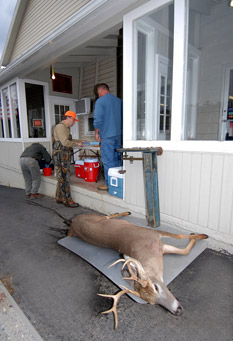Between 2002 and 2020, over 32,000 free-ranging white-tailed deer in Virginia have been tested for chronic wasting disease (CWD). Below is a summary of CWD surveillance efforts in Virginia since 2005. In addition to the sampling efforts in the Disease Management Areas, as described below, DWR partners with dozens of taxidermists every hunting season to enhance CWD surveillance throughout the remainder of Virginia. Since older males are the gender and age class most likely to be infected with CWD, this targeted surveillance strategy is a more efficient method of CWD surveillance. The results of the 2021 – 22 statewide CWD surveillance effort are not yet finalized and will be released once received from the laboratory.

The map below shows the location of Virginia’s CWD-positive deer from 2009 to 2021. During the first few years of Virginia’s CWD outbreak, infected deer were found in a small cluster located very close to the West Virginia state line. Beginning in 2013, CWD-positive deer began to be detected southeast of the established cluster. Since then, the disease has spread in an east/southeast direction. In 2020, CWD was confirmed over 160 miles from the nearest detection in Montgomery County.

Once CWD is confirmed in a new county or within 10-miles of the boundary of an existing Disease Management Area (DMA), a 10-mile buffer is drawn around the detection. All counties included within the 10-mile buffer are incorporated into either an existing DMA or into a newly created DMA. CWD monitoring within a DMA consists mainly of hunter-harvested (methods of collection include taxidermists, processors, and voluntary testing) and road-kill deer. Both male and female deer and all age classes (with the exception of fawns) are tested. During the 2021 -22 deer hunting season, four counties were included in DMA1 (Clarke, Frederick, Shenandoah, and Warren), seven counties encompassed DMA2 (Culpeper, Fauquier, Loudoun, Madison, Orange, Page, and Rappahannock), and three counties made up DMA3 (Floyd, Montgomery, and Pulaski).The map below shows the 2021 – 22 deer hunting season sample distribution for DMA1, DMA2, and DMA3 surrounding counties.

The table below outlines the timing and location of CWD detections in Virginia.
| Timeline of CWD Detections | |||||||||||||
| County | 2009 | 2010 | 2011 | 2012 | 2013 | 2014 | 2015 | 2016 | 2017 | 2018 | 2019 | 2020 | 2021 |
|---|---|---|---|---|---|---|---|---|---|---|---|---|---|
| Frederick | 1 | 1 | 2 | 1 | 2 | 2 | 3 | 9 | 14 | 26 | 13* | 13* | 17* |
| Shenandoah | 1 | 2 | 2 | 5 | 2 | 1 | |||||||
| Culpeper | 1 | 1 | |||||||||||
| Clarke | 2 | 1 | |||||||||||
| Fauquier | 1 | 1 | 2 | ||||||||||
| Loudoun | 1 | 1 | |||||||||||
| Madison | 1 | ||||||||||||
| Rappahannock | 1 | ||||||||||||
| Warren | 1 | ||||||||||||
| Montgomery | 1 | 1 | |||||||||||
| Orange | |||||||||||||
| Page | |||||||||||||
| Floyd | 1 | ||||||||||||
| Total detections | 1 | 1 | 2 | 1 | 2 | 3 | 3 | 9 | 16 | 29 | 21 | 21 | 25 |
* Reduced detections are reflective of a shift in surveillance effort and focus away from core-affected counties (i.e. Frederick County) to counties where the disease is not yet established.

Above: A deer is checked and sampled at a CWD sampling station. Photo credit: DWR

Above: Tissue samples are collected for testing at a CWD sampling station. Photo credit: DWR


